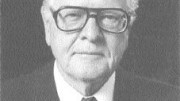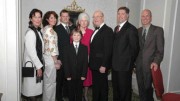James John (Jim) McDougall died in April at 86 years old.
Born in Grand Forks, B.C., he attended school there and then served overseas in Holland during the Second World War.
He graduated from the University of British Columbia as a geologist and mining engineer with a BA in 1951 and an MSc in geology in 1954.
After graduation he worked for various Thayer Lindsley companies, eventually settling at Ventures Limited. When Ventures merged with Falconbridge Nickel Mines in 1962, he continued in charge of exploration. He was appointed manager of western exploration in 1970, and remained in that position until he ostensibly retired in 1980, only to become a sought-after consultant.
Jimmy Mac, as he was affectionately known, was one of B.C.’s most talented, tenacious, and successful geologists – a reputation he earned by boldly going where few geologists had gone before. He found or helped discover more than 16 major mineral deposits during a career that spanned more than half a century.
His most significant and famous discovery lies within a park in B.C. and may not be mined for several years. His pioneering work in the discovery of the world-class Windy Craggy copper-gold-cobalt deposit puts him right alongside Canada’s other great mine-finders.
McDougall’s legacy of discovery over those decades reflects the diverse mineral potential of the Western Cordillera. His credits include the Catface porphyry copper deposit on Vancouver Island’s west coast, the Tasu iron-copper mine on the Queen Charlotte Islands, the Banks Island gold project near Prince Rupert, and the Sustut copper deposit in north-central B.C.
McDougall’s technical skills, vision and dedication to working whenever there was daylight all contributed to his prospecting success. But another important factor was his eagerness to explore rugged, remote and sometimes uncharted wilderness areas from Alaska to western Alberta. He was among the first to use fixed-wing planes and then helicopters to explore new terrain, and among the first to make use of advanced geochemical and geophysical techniques.
McDougall was very field-oriented and would push you to your limits to use all the exploration techniques and tools available. He would insist you carry out soil and stream-sediment sampling, use both the magnetometer and VLF EM16, know the geology, and find the mineralization. All of this was to be done in two or three months, so that he could send out the drill and be finished by September.
A little known fact about McDougall is that he was instrumental in saving two lives. On July 26, 1959, Bob Sheldon (working for Newmont) crash-landed in a helicopter near the Brady Glacier in Alaska while looking at a gossan. One person died, and Sheldon and the pilot were injured.
They remained unfound until Aug. 2, when McDougall, exploring the Windy Craggy area, came to the conclusion that Sheldon would have been looking for gossans. He flew around the search area and found the same gossan that Bob initially tried to land on. Immediately he and the Falconbridge pilot Roy Hepworth located the stranded party, landed their Hiller 12E and flew them to Taylor Beach where they were transferred to Juneau.
McDougall was a true prospector-geologist and would grubstake many prospectors on a handshake. He even tried out sulphide-sniffing pooches.
Whatever you called him – Jimmy, Jimmy Mac, Jim McDougall – he was a memorable character. His shyness was a front for a sharp, well-informed geological mind. He was as adept at “prospecting” apparently casual conversations as he was at putting geological puzzles together.
In other words, McDougall surrounded himself with competent, reliable and loyal people who came to accept his sometimes abrasive and work-dedicated personality.
He was a member of the CIM, AMEBC, SEG, PDAC and APEGBC. And McDougall’s achievements have not gone unnoticed. He was named Prospector of the Year by the PDAC in 1985. In 1987 he received the Spud Huestis Award from the then-B.C. & Yukon Chamber of Mines, an organization that he supported for many decades. In January 2006, McDougall was inducted into the Canadian Mining Hall of Fame. In 2009, he received the A.O. Dufresne award from the Canadian Institute of Mining, Metallurgy and Petroleum.
There was one person who was very
instrumental in his life: Sophie McDougall. Jim married Sophie in 1965. She stood by him throughout his career and those many, many days when he was in the bush.
– The author is CEO of Module Resources and had been McDougall’s close friend and colleague since they first worked together for Falconbridge in 1974.





Be the first to comment on "Obituary: Remembering ‘Jimmy Mac’ McDougall"